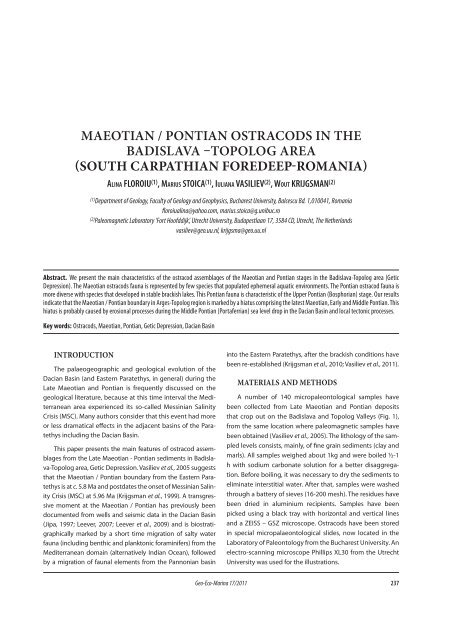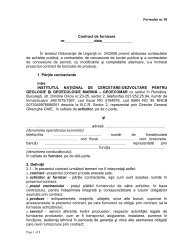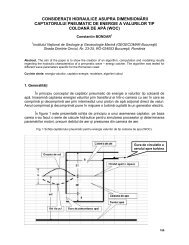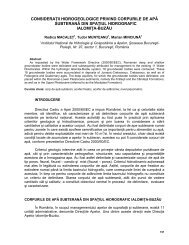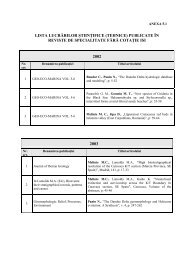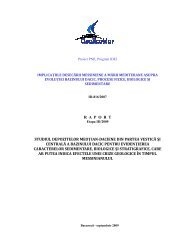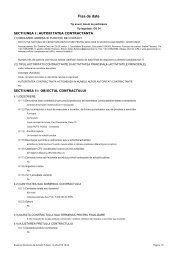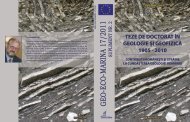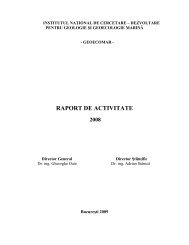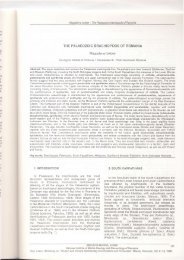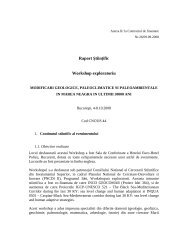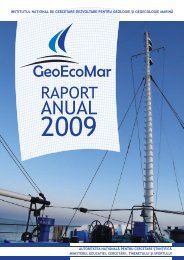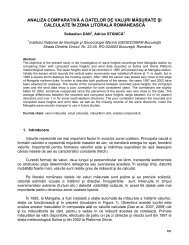Maeotian / Pontian ostracods in the Badislava ... - GeoEcoMar
Maeotian / Pontian ostracods in the Badislava ... - GeoEcoMar
Maeotian / Pontian ostracods in the Badislava ... - GeoEcoMar
Create successful ePaper yourself
Turn your PDF publications into a flip-book with our unique Google optimized e-Paper software.
A. FLOROIU, M. STOICA, I. VASILIEV, W. KRIJGSMAN<br />
<strong>Maeotian</strong> / <strong>Pontian</strong> <strong>ostracods</strong> <strong>in</strong> <strong>the</strong><br />
<strong>Badislava</strong> –Topolog area<br />
(South carpathian foredeep-Romania)<br />
Al<strong>in</strong>a FLOROIU (1) , Marius STOICA (1) , Iuliana VASILIEV (2) , Wout KRIJGSMAN (2)<br />
(1) Department of Geology, Faculty of Geology and Geophysics, Bucharest University, Balcescu Bd. 1,010041, Romania<br />
floroiual<strong>in</strong>a@yahoo.com, marius.stoica@g.unibuc.ro<br />
(2) Paleomagnetic Laboratory ‘Fort Hoofddijk’, Utrecht University, Budapestlaan 17, 3584 CD, Utrecht, The Ne<strong>the</strong>rlands<br />
vasiliev@geo.uu.nl, krijgsma@geo.uu.nl<br />
Abstract. We present <strong>the</strong> ma<strong>in</strong> characteristics of <strong>the</strong> ostracod assemblages of <strong>the</strong> <strong>Maeotian</strong> and <strong>Pontian</strong> stages <strong>in</strong> <strong>the</strong> <strong>Badislava</strong>-Topolog area (Getic<br />
Depression). The <strong>Maeotian</strong> <strong>ostracods</strong> fauna is represented by few species that populated ephemeral aquatic environments. The <strong>Pontian</strong> ostracod fauna is<br />
more diverse with species that developed <strong>in</strong> stable brackish lakes. This <strong>Pontian</strong> fauna is characteristic of <strong>the</strong> Upper <strong>Pontian</strong> (Bosphorian) stage. Our results<br />
<strong>in</strong>dicate that <strong>the</strong> <strong>Maeotian</strong> / <strong>Pontian</strong> boundary <strong>in</strong> Arges-Topolog region is marked by a hiatus compris<strong>in</strong>g <strong>the</strong> latest <strong>Maeotian</strong>, Early and Middle <strong>Pontian</strong>. This<br />
hiatus is probably caused by erosional processes dur<strong>in</strong>g <strong>the</strong> Middle <strong>Pontian</strong> (Portaferrian) sea level drop <strong>in</strong> <strong>the</strong> Dacian Bas<strong>in</strong> and local tectonic processes.<br />
Key words: Ostracods, <strong>Maeotian</strong>, <strong>Pontian</strong>, Getic Depression, Dacian Bas<strong>in</strong><br />
Introduction<br />
The palaeogeographic and geological evolution of <strong>the</strong><br />
Dacian Bas<strong>in</strong> (and Eastern Paratethys, <strong>in</strong> general) dur<strong>in</strong>g <strong>the</strong><br />
Late <strong>Maeotian</strong> and <strong>Pontian</strong> is frequently discussed on <strong>the</strong><br />
geological literature, because at this time <strong>in</strong>terval <strong>the</strong> Mediterranean<br />
area experienced its so-called Mess<strong>in</strong>ian Sal<strong>in</strong>ity<br />
Crisis (MSC). Many authors consider that this event had more<br />
or less dramatical effects <strong>in</strong> <strong>the</strong> adjacent bas<strong>in</strong>s of <strong>the</strong> Paratethys<br />
<strong>in</strong>clud<strong>in</strong>g <strong>the</strong> Dacian Bas<strong>in</strong>.<br />
This paper presents <strong>the</strong> ma<strong>in</strong> features of ostracod assemblages<br />
from <strong>the</strong> Late <strong>Maeotian</strong> - <strong>Pontian</strong> sediments <strong>in</strong> <strong>Badislava</strong>-Topolog<br />
area, Getic Depression. Vasiliev et al., 2005 suggests<br />
that <strong>the</strong> <strong>Maeotian</strong> / <strong>Pontian</strong> boundary from <strong>the</strong> Eastern Paratethys<br />
is at c. 5.8 Ma and postdates <strong>the</strong> onset of Mess<strong>in</strong>ian Sal<strong>in</strong>ity<br />
Crisis (MSC) at 5.96 Ma (Krijgsman et al., 1999). A transgressive<br />
moment at <strong>the</strong> <strong>Maeotian</strong> / <strong>Pontian</strong> has previously been<br />
documented from wells and seismic data <strong>in</strong> <strong>the</strong> Dacian Bas<strong>in</strong><br />
(Jipa, 1997; Leever, 2007; Leever et al., 2009) and is biostratigraphically<br />
marked by a short time migration of salty water<br />
fauna (<strong>in</strong>clud<strong>in</strong>g benthic and planktonic foram<strong>in</strong>ifers) from <strong>the</strong><br />
Mediterranean doma<strong>in</strong> (alternatively Indian Ocean), followed<br />
by a migration of faunal elements from <strong>the</strong> Pannonian bas<strong>in</strong><br />
<strong>in</strong>to <strong>the</strong> Eastern Paratethys, after <strong>the</strong> brackish conditions have<br />
been re-established (Krijgsman et al., 2010; Vasiliev et al., 2011).<br />
Materials and methods<br />
A number of 140 micropaleontological samples have<br />
been collected from Late <strong>Maeotian</strong> and <strong>Pontian</strong> deposits<br />
that crop out on <strong>the</strong> <strong>Badislava</strong> and Topolog Valleys (Fig. 1),<br />
from <strong>the</strong> same location where paleomagnetic samples have<br />
been obta<strong>in</strong>ed (Vasiliev et al., 2005). The lithology of <strong>the</strong> sampled<br />
levels consists, ma<strong>in</strong>ly, of f<strong>in</strong>e gra<strong>in</strong> sediments (clay and<br />
marls). All samples weighed about 1kg and were boiled ½-1<br />
h with sodium carbonate solution for a better disaggregation.<br />
Before boil<strong>in</strong>g, it was necessary to dry <strong>the</strong> sediments to<br />
elim<strong>in</strong>ate <strong>in</strong>terstitial water. After that, samples were washed<br />
through a battery of sieves (16-200 mesh). The residues have<br />
been dried <strong>in</strong> alum<strong>in</strong>ium recipients. Samples have been<br />
picked us<strong>in</strong>g a black tray with horizontal and vertical l<strong>in</strong>es<br />
and a ZEISS – GSZ microscope. Ostracods have been stored<br />
<strong>in</strong> special micropalaeontological slides, now located <strong>in</strong> <strong>the</strong><br />
Laboratory of Paleontology from <strong>the</strong> Bucharest University. An<br />
electro-scann<strong>in</strong>g microscope Phillips XL30 from <strong>the</strong> Utrecht<br />
University was used for <strong>the</strong> illustrations.<br />
Geo-Eco-Mar<strong>in</strong>a 17/2011<br />
237
A. Floroiu, M. Stoica, I. Vasiliev, W. Krijgsman – <strong>Maeotian</strong> / <strong>Pontian</strong> <strong>ostracods</strong> <strong>in</strong> <strong>the</strong> <strong>Badislava</strong> –Topolog area<br />
Fig. 1. a) Simplified geotectonic map of Romanian Carpathians with <strong>the</strong> location of <strong>the</strong> study area; b) Geological map of <strong>the</strong> <strong>Badislava</strong> and<br />
Topolog Valleys area with <strong>the</strong> position of micropaleontological samples; c) North–South schematic cross section on <strong>the</strong> studied area; Figures a)<br />
and b) modified from Vasiliev et al., 2005<br />
Geological background<br />
The Getic Depression represents <strong>the</strong> sedimentary bas<strong>in</strong><br />
that developed at <strong>the</strong> contact between <strong>the</strong> South Carpathian<br />
nappe pile and <strong>the</strong> Moesian Platform (Sandulescu et al.,<br />
1984). The Late Miocene-Pliocene sedimentary successions<br />
from <strong>Badislava</strong> and Topolog Valleys regions are <strong>in</strong>tegrated<br />
<strong>in</strong>to a large monocl<strong>in</strong>al structure with 15 o -20 o plunge to <strong>the</strong><br />
SSE (Fig. 1). This structure is affected by N-S oriented faults<br />
that can generate up to 200 m of horizontal displacements.<br />
The Mio-Pliocene sedimentary successions are very well<br />
exposed <strong>in</strong> <strong>the</strong> nor<strong>the</strong>rn part of <strong>the</strong> Getic Depression, especially<br />
<strong>in</strong> <strong>the</strong> Topolog Valley. A magnetostratigraphic time<br />
scale has been developed for <strong>the</strong> <strong>Maeotian</strong>-Romanian deposits<br />
from this area (Vasiliev et al., 2005). The magnetic polarity<br />
pattern recorded <strong>in</strong> <strong>the</strong>se sections shows a succession of four<br />
relatively short normal and three reversed zones, followed by<br />
a long reversed <strong>in</strong>terval. The results were later <strong>in</strong>tegrated with<br />
biostratigraphical data based on mollusks (Stoica et al., 2007).<br />
The studied sections start <strong>in</strong> <strong>the</strong> Late <strong>Maeotian</strong> and end<br />
<strong>in</strong> <strong>the</strong> lower part of <strong>the</strong> Romanian, south of <strong>the</strong> confluence<br />
between <strong>the</strong> <strong>Badislava</strong> and Topolog Valleys (Fig. 1). The Upper<br />
<strong>Maeotian</strong> stage is here developed <strong>in</strong> a fluviatile-deltaic<br />
facies with frequently cont<strong>in</strong>ental type <strong>in</strong>tercalations. The<br />
sediments are represented by coarse gravels, oblique lam<strong>in</strong>ated<br />
sands, channel deposits <strong>in</strong>terbedded with “flood-pla<strong>in</strong>”<br />
deposits, fossil soils and lacustr<strong>in</strong>e clay (Figs 2, 4).<br />
The top of <strong>the</strong> <strong>Maeotian</strong> sequence is marked by an erosional<br />
surface. The overly<strong>in</strong>g <strong>Pontian</strong> deposits have a transgressive<br />
character. They are represented by a f<strong>in</strong><strong>in</strong>g-upward sequence<br />
that starts with coarse to medium-gra<strong>in</strong>ed pebbles and sands<br />
<strong>in</strong> <strong>the</strong> lower part, pass<strong>in</strong>g to predom<strong>in</strong>ant f<strong>in</strong>e-gra<strong>in</strong>ed deposits<br />
very rich <strong>in</strong> mollusks and <strong>ostracods</strong> <strong>in</strong> <strong>the</strong> upper part (Figs 3,<br />
4). This discont<strong>in</strong>uity <strong>in</strong> <strong>the</strong> marg<strong>in</strong>al areas of central part of <strong>the</strong><br />
Carpathian Foredeep can also be noticed on <strong>the</strong> <strong>in</strong>terpretations<br />
of seismic l<strong>in</strong>es from <strong>the</strong> westernmost part of <strong>the</strong> Dacian<br />
Bas<strong>in</strong> (Leever, 2007, Leever et al., 2009).<br />
Results and discussion<br />
Based on detailed mapp<strong>in</strong>g and sampl<strong>in</strong>g of <strong>the</strong> <strong>Maeotian</strong><br />
and <strong>Pontian</strong> sequences from <strong>the</strong> <strong>in</strong>vestigated area we<br />
present here <strong>the</strong> ma<strong>in</strong> characteristics of <strong>the</strong> ostracod assemblages<br />
from this time <strong>in</strong>terval and a reconstruction of <strong>the</strong> palaeoenvironments.<br />
The Upper <strong>Maeotian</strong> deposits from <strong>the</strong> <strong>Badislava</strong> and<br />
Toplog sections reach up to 250 m <strong>in</strong> thickness. Sediments<br />
are represented by coarse gravels, oblique lam<strong>in</strong>ated sands,<br />
channel and “flood-pla<strong>in</strong>” type deposits, fossil soils and lacustr<strong>in</strong>e<br />
clays (Figs. 2, 4). The f<strong>in</strong>e-gra<strong>in</strong>ed <strong>in</strong>tercalations are<br />
238 Geo-Eco-Mar<strong>in</strong>a 17/2011
A. Floroiu, M. Stoica, I. Vasiliev, W. Krijgsman – <strong>Maeotian</strong> / <strong>Pontian</strong> <strong>ostracods</strong> <strong>in</strong> <strong>the</strong> <strong>Badislava</strong> –Topolog area<br />
Fig. 2. Litho-facial aspects of <strong>Maeotian</strong> deposits from <strong>Badislava</strong> Valley section; a) Fluvial deposits with sands and gravel lenses; b) Small channel<br />
cut on flood pla<strong>in</strong> deposits; on <strong>the</strong> edge of <strong>the</strong> channel, can be observed fossil roots <strong>in</strong> orig<strong>in</strong>al position; c) Interbedded blackish fossil soils and<br />
flood-pla<strong>in</strong> silts; d) Erosional contact between Upper <strong>Maeotian</strong> flood-pla<strong>in</strong> deposits and Upper <strong>Pontian</strong> littoral sands and f<strong>in</strong>e gravels<br />
represented by gray or brownish clays and silts with frequent<br />
calcareous concretions, as well as blackish layers rich <strong>in</strong> plant<br />
debris. They are very scarce <strong>in</strong> fossil rema<strong>in</strong>s, only few bad preserved<br />
shells of cont<strong>in</strong>ental or freshwater gastropods (species<br />
of Helicidae and Planorbidae) and bivalves (species of Unionidae)<br />
have been observed (Stoica et al., 2007). The microfauna<br />
is represented by few species of fresh water <strong>ostracods</strong>:<br />
Candoniella sp.; Candona sp.; Paracandona albicans (Brady);<br />
Ilyocypris bradyi Sars (Fig 4, Plate 1). These species populated<br />
unstable environments, such as lakes, rivers with temporary<br />
existence and flood-pla<strong>in</strong>s. Paracandona albicans, (<strong>the</strong> adult<br />
specimens show reticulate valves easy to be confused with<br />
juveniles of Pseudocandona Kaufman), lives <strong>in</strong> fresh-water rivers,<br />
lakes and pools. In <strong>the</strong> Dacian Bas<strong>in</strong>, it has been described<br />
<strong>in</strong> <strong>the</strong> <strong>Maeotian</strong>, Dacian and Romanian fresh water sediments<br />
associated with Cyprideis heterostigma sublittoralis and Cyclocypris<br />
sp (Olteanu <strong>in</strong> Papaianopol et al., 1987; Olteanu, 1995).<br />
This scarce <strong>Maeotian</strong> ostracod fauna from <strong>in</strong>vestigated area<br />
differs essentially from <strong>the</strong> diversified one of <strong>the</strong> same stage<br />
from zones that evolved <strong>in</strong> bas<strong>in</strong>al conditions.<br />
Above <strong>the</strong> erosional surface, <strong>the</strong> <strong>Pontian</strong> starts with sands<br />
and silts, that frequent present wave ripples structures, which<br />
pass to more f<strong>in</strong>e-gra<strong>in</strong>ed deposits <strong>in</strong> <strong>the</strong> upper part. The f<strong>in</strong>egra<strong>in</strong>ed<br />
sediments provided a rich ostracod fauna, <strong>in</strong>dicative<br />
of <strong>the</strong> Upper <strong>Pontian</strong> (Bosphorian): Amplocypris dorsobrevis<br />
Sokac; Scottia sp.; Cypria tocorjescui Hanganu; Candona (Caspiocypris)<br />
ex. gr. alta (Zal.); Candona (Caspiolla) osso<strong>in</strong>ae Krst.;<br />
Candona (Caspiolla) venusta (Zal.); Candona (Pontoniella) acum<strong>in</strong>ata<br />
striata Mandelstam; Candona (Pontoniella) excellentis<br />
Olteanu; Candona (Pontoniella) sp.; Candona neglecta Sars;<br />
Bakunella dorsoarcuata (Zal.); Bakunella sp.; Cyprideis sp.1;<br />
Cyprideis sp. 2; Tyrrhenocy<strong>the</strong>re filipescui (Hanganu); Tyrrhenocy<strong>the</strong>re<br />
motasi Olteanu; Tyrrhenocy<strong>the</strong>re sp.1; Tyrrhenocy<strong>the</strong>re<br />
sp.2; Leptocy<strong>the</strong>re (Amnicy<strong>the</strong>re) palimpsesta Liv.; Leptocy<strong>the</strong>re<br />
Geo-Eco-Mar<strong>in</strong>a 17/2011<br />
239
A. Floroiu, M. Stoica, I. Vasiliev, W. Krijgsman – <strong>Maeotian</strong> / <strong>Pontian</strong> <strong>ostracods</strong> <strong>in</strong> <strong>the</strong> <strong>Badislava</strong> –Topolog area<br />
picturata Liv.; Leptocy<strong>the</strong>re (Amnicy<strong>the</strong>re) multituberculata<br />
(Liv.); Leptocy<strong>the</strong>re sp.; Leptocy<strong>the</strong>re () ex. gr. bosqueti (Liv.);<br />
Loxoconcha babazananica Liv.; Loxoconcha schweyeri Suz<strong>in</strong>;<br />
Loxoconcha petasa Liv.; Loxoconcha sp. (Fig. 4, Plate 1).<br />
The Bosphorian <strong>ostracods</strong> are more abundant and are<br />
represented by typical species of this sub-stage, as well as by<br />
species that cont<strong>in</strong>ue to exist <strong>in</strong> <strong>the</strong> Lower Dacian (Getian). In<br />
<strong>the</strong> Dacian Bas<strong>in</strong>, Cypria tocorjescui was described for <strong>the</strong> first<br />
time (Hanganu, 1962) from so-called Paradacna abichi levels<br />
(Lower <strong>Pontian</strong>) and, apparently, it migrated from <strong>the</strong> Pannonian<br />
Bas<strong>in</strong> (Pipick <strong>in</strong> Cziczer et al. 2009). This species was also<br />
noticed <strong>in</strong> <strong>the</strong> Upper <strong>Pontian</strong> sediments with Phyllocardium<br />
planum planum bivalve shells (Hanganu, 1974).<br />
In our samples, we observed <strong>the</strong> high abundance of<br />
Tyrrhenocy<strong>the</strong>re species. Most of <strong>the</strong>m appeared <strong>in</strong> <strong>the</strong> Dacian<br />
Bas<strong>in</strong> dur<strong>in</strong>g <strong>the</strong> Middle <strong>Pontian</strong> (Portaferrian) and are<br />
well represented <strong>in</strong> <strong>the</strong> Upper <strong>Pontian</strong> (Boshporian), too. The<br />
“bloom” of Tyrrhenocy<strong>the</strong>re filipescui Hanganu <strong>in</strong> Bosphorian<br />
is accompanied by <strong>the</strong> presence of Scottia sp. (Hanganu,<br />
1985). T. filipescui is <strong>the</strong> most conservative species of <strong>the</strong> genus<br />
hav<strong>in</strong>g <strong>the</strong> most extended distribution <strong>in</strong> time, from <strong>the</strong><br />
base of Middle <strong>Pontian</strong> up to <strong>the</strong> Lower Dacian (Olteanu and<br />
Vekua, 1989).<br />
The first apparition of Bakunella genus is recorded, start<strong>in</strong>g<br />
with <strong>the</strong> second part of <strong>the</strong> Lower <strong>Pontian</strong>. Dur<strong>in</strong>g <strong>the</strong> <strong>Pontian</strong>,<br />
this genus is represented by one species: Bakunella dorsoarcuata<br />
(Zal.). This species seems to be ra<strong>the</strong>r conservative concern<strong>in</strong>g<br />
<strong>the</strong> ornamentation pattern along <strong>the</strong> <strong>Pontian</strong>, some<br />
changes appear<strong>in</strong>g only dur<strong>in</strong>g <strong>the</strong> Dacian (Olteanu, 1989). B.<br />
dorsoarcuata probably evolved <strong>in</strong> Lake Pannon and was endemic<br />
to that lake until <strong>the</strong> Latest Miocene (Pipick <strong>in</strong> Cziczer et<br />
al. 2009). This species is liv<strong>in</strong>g today <strong>in</strong> sublittoral to profundal<br />
depths, <strong>in</strong> <strong>the</strong> central and sou<strong>the</strong>rn Caspian Bas<strong>in</strong>, at sal<strong>in</strong>ities<br />
of 11.5–13.5% (Gofman 1966, Boomer et al. 2005). Gliozzi,<br />
2007, mentioned <strong>the</strong> presence of B. dorsoarcuata <strong>in</strong> <strong>the</strong> Late<br />
Tortonian - Early Mess<strong>in</strong>ian deposits from Mediterranean area<br />
toge<strong>the</strong>r with o<strong>the</strong>r <strong>ostracods</strong> that migrated from Paratethys<br />
before <strong>the</strong> onset of MSC. Pontoniella genus emerged with <strong>the</strong><br />
Lower <strong>Pontian</strong>, followed immediately by Bakunella.<br />
Fig. 3. Litho-facial aspects of Upper <strong>Pontian</strong> deposits from <strong>Badislava</strong> Valley section a) Sandy littoral deposits with pelitic <strong>in</strong>tercalations transgressively<br />
overlay<strong>in</strong>g <strong>the</strong> Meotian deposits (basal part of Upper <strong>Pontian</strong>, left bank of <strong>Badislava</strong> Valley); b) Symmetrical wave ripples on Upper <strong>Pontian</strong><br />
sandy deposits; c) Upper <strong>Pontian</strong> <strong>in</strong>terbedded marls and silts nicely exposed on <strong>the</strong> <strong>Badislava</strong> River; d) Silty layer very rich <strong>in</strong> mollusk shells<br />
(Limnocardiidae bivalves and Vivipariidae gastropods)<br />
240 Geo-Eco-Mar<strong>in</strong>a 17/2011
A. Floroiu, M. Stoica, I. Vasiliev, W. Krijgsman – <strong>Maeotian</strong> / <strong>Pontian</strong> <strong>ostracods</strong> <strong>in</strong> <strong>the</strong> <strong>Badislava</strong> –Topolog area<br />
Fig. 4. Syn<strong>the</strong>thic log, ma<strong>in</strong> litho-logical characteristics and ostracod assemblages of Upper <strong>Maeotian</strong>, Upper <strong>Pontian</strong> deposits from<br />
<strong>Badislava</strong> Valley section<br />
Geo-Eco-Mar<strong>in</strong>a 17/2011<br />
241
A. Floroiu, M. Stoica, I. Vasiliev, W. Krijgsman – <strong>Maeotian</strong> / <strong>Pontian</strong> <strong>ostracods</strong> <strong>in</strong> <strong>the</strong> <strong>Badislava</strong> –Topolog area<br />
PLATE 1 <strong>Maeotian</strong> and <strong>Pontian</strong> <strong>ostracods</strong> from <strong>Badislava</strong> Valley section (all specimens represent adult valves, external lateral views,<br />
LV=left valve, RV=right valve, BBM 09-micropaleontological sample). 1. Candoniella sp., LV, <strong>Maeotian</strong>, (BBM 09); 2. Paracandona albicans (Brady), LV,<br />
<strong>Maeotian</strong>, (BBM 11); 3. Iliocypris bradyi Sars, RV, <strong>Maeotian</strong>, (BBM 09); 4. Amplocypris dorsobrevis Sokac, RV, Upper <strong>Pontian</strong>, (BBM 41); 5. Cypria tocorjescui<br />
Hanganu, RV, Upper <strong>Pontian</strong>, (BBM 47); 6. Scottia sp., RV, Upper <strong>Pontian</strong>, (BBM 39); 7. Candona (Caspiocypris) ex. gr. alta (Zal.), LV, Upper <strong>Pontian</strong>,<br />
(BBM 43); 8. Candona (Caspiolla) osso<strong>in</strong>ae Krst., LV, Upper <strong>Pontian</strong>, (BBM 39); 9. Candona (Caspiolla) venusta (Zal.), LV, Upper <strong>Pontian</strong>, (BBM 40);<br />
10. Candona (Pontoniella) acum<strong>in</strong>ata striata Mandelstam, RV, Upper <strong>Pontian</strong>, (BBM 28); 11. Candona (Pontoniella) sp., RV, Upper <strong>Pontian</strong>, (BBM 40);<br />
12. Candona (Pontoniella) excellentis Olteanu, LV, Upper <strong>Pontian</strong>, (BBM 28); 13. Candona neglecta Sars, RV, Upper <strong>Pontian</strong>, (BBM 50); 14. Bakunella<br />
dorsoarcuata (Zal.), RV, Upper <strong>Pontian</strong>, (BBM 52); 15. Cyprideis sp. 1, RV, Upper <strong>Pontian</strong>, (BBM 40); 16. Cyprideis sp. 2, RV, Upper <strong>Pontian</strong>, (BBM 41);<br />
17. Tyrrhenocy<strong>the</strong>re filipescui (Hanganu), LV, Upper <strong>Pontian</strong>, (BBM 33); 18. Tyrrhenocy<strong>the</strong>re motasi Olteanu, LV, Upper <strong>Pontian</strong>, (BBM 33); 19. Leptocy<strong>the</strong>re<br />
(Amnicy<strong>the</strong>re) palimpsesta Liv., RV, Upper <strong>Pontian</strong>, (BBM 47); 20. Leptocy<strong>the</strong>re () ex. gr. bosqueti (Liv.), LV, Upper <strong>Pontian</strong>, (BBM 38);<br />
21. Loxoconcha schweyeri Suz<strong>in</strong>, RV, Upper <strong>Pontian</strong>, (BBM 52); 22. Loxoconcha babazananica Liv., RV, Upper <strong>Pontian</strong>, (BBM 48)<br />
242 Geo-Eco-Mar<strong>in</strong>a 17/2011
A. Floroiu, M. Stoica, I. Vasiliev, W. Krijgsman – <strong>Maeotian</strong> / <strong>Pontian</strong> <strong>ostracods</strong> <strong>in</strong> <strong>the</strong> <strong>Badislava</strong> –Topolog area<br />
An important characteristic of ostracod assemblage<br />
from <strong>the</strong> <strong>in</strong>vestigated area is represented by <strong>the</strong> high development<br />
of Amplocypris genus, <strong>in</strong> <strong>the</strong> second part of Upper<br />
<strong>Pontian</strong>. This genus, with a large shell is represented by<br />
Amplocypris dorsobrevis Sokač, and has been found <strong>in</strong> several<br />
localities with <strong>Pontian</strong> sediments from Dacian Bas<strong>in</strong>, as well<br />
as <strong>in</strong> Yugoslavia (Hanganu, 1976, Sokač, 1989). A similar species<br />
is described by (Olteanu, 1995) from <strong>the</strong> Lower Dacian<br />
sediments (Mare Valley-Bengesti) as A. odessaensis (Ilnitzkaia).<br />
However, some additional morphometric studies are needed<br />
to f<strong>in</strong>d out which are <strong>the</strong> real Amplocypris species <strong>in</strong> <strong>the</strong><br />
Dacian Bas<strong>in</strong>. The Cyprideis genus is represented by several<br />
different morphotypes, but, for <strong>the</strong> moment, it is difficult to<br />
mention <strong>the</strong>ir specific affiliation.<br />
The Upper <strong>Pontian</strong> (Bosphorian) deposits from <strong>the</strong> study<br />
area conta<strong>in</strong> also very rich mollusk assemblages dom<strong>in</strong>ated<br />
by brackish bivalves and gastropods (Stoica et al., 2007).<br />
Conclusions<br />
The <strong>Maeotian</strong> / <strong>Pontian</strong> transition on <strong>Badislava</strong> Valley section<br />
comprises an erosional event, with Upper <strong>Pontian</strong> sediments<br />
discordantly overly<strong>in</strong>g <strong>the</strong> <strong>Maeotian</strong> deposits, possibly,<br />
as a consequence of <strong>the</strong> Middle <strong>Pontian</strong> sea level drop<br />
<strong>in</strong> <strong>the</strong> Dacian Bas<strong>in</strong> or local tectonic processes. There are no<br />
<strong>in</strong>dications for <strong>the</strong> presence of <strong>the</strong> Lower and Middle <strong>Pontian</strong><br />
(Odessian and Portaferrian) substages.<br />
This onset of <strong>the</strong> Upper <strong>Pontian</strong> littoral sediments followed<br />
by shallow bas<strong>in</strong>al ones directly on <strong>the</strong> <strong>Maeotian</strong><br />
fluvial deposits is related to a transgressive moment <strong>in</strong> <strong>the</strong><br />
Dacian Bas<strong>in</strong>. This is <strong>the</strong> last important high stand period<br />
<strong>in</strong> <strong>the</strong> Dacian Bas<strong>in</strong> and can possibly be correlated with <strong>the</strong><br />
Zanclean transgression (5.33 Ma) of <strong>the</strong> Mediterranean Bas<strong>in</strong>.<br />
This event marks <strong>the</strong> Miocene / Pliocene boundary and illustrates<br />
<strong>the</strong> complex <strong>in</strong>teractions between <strong>the</strong> Mediterranean<br />
and Oriental Paratethys Bas<strong>in</strong>s (<strong>in</strong>clud<strong>in</strong>g <strong>the</strong> Dacian Bas<strong>in</strong>) <strong>in</strong><br />
Late Miocene – Early Pliocene times.<br />
The <strong>Maeotian</strong> ostracod fauna is pore developed and is<br />
represented by few fresh water species able to populate<br />
ephemeral aquatic environments. By contrast, <strong>the</strong> Upper<br />
<strong>Pontian</strong> one is more diverse and conta<strong>in</strong>s numerous species<br />
characteristic for brackish and more stable shallow water environment.<br />
References<br />
Boomer I., von Grafenste<strong>in</strong> U., Guichard F., Bieda S., 2005. Modern and<br />
Holocene sublittoral ostracod assemblages (Crustacea) from <strong>the</strong><br />
Caspian Sea: A unique brackish, deep-water environment. Palaeogeography,<br />
Palaeoclimatology, Palaeoecology, 225: 173–186.<br />
Cziczer I., Magyar I., Pipík R., Böhme M., Ćorić S., Bakrač K., Sütő-Szentai M.,<br />
Lantos M., Bab<strong>in</strong>szki E., Müller P., 2009. Life <strong>in</strong> <strong>the</strong> sublittoral zone<br />
of long-lived Lake Pannon: paleontological analysis of <strong>the</strong> Upper<br />
Miocene Szák Formation, Hungary. Int. J. Earth Sci (Geol Rundsch),<br />
98: 1741 -1766.<br />
Gliozzi E., Ceci M.E., Grossi F., & Ligios S., 2007. Paratethyan Ostracod immigrants<br />
<strong>in</strong> Italy dur<strong>in</strong>g <strong>the</strong> Late Miocene. Geobios, 40 (3): 325-337.<br />
Gofman E.A., 1966. Ekologia sovremennykh i novokaspiiskikh ostrakod<br />
Kaspiiskogo moria (Ecology of <strong>the</strong> liv<strong>in</strong>g and new Caspian<br />
ostracodes of <strong>the</strong> Caspian Sea). Nauka, Moscow, pp. 1-183.<br />
Hanganu E., 1974. Observation sur l‘ostracofaune pontienne de la région<br />
comprise a la vallée du Danube et la vallée du Motru. Revista<br />
Española de Micropaleontologia VI(3): 335-345.<br />
Hanganu E., 1976. Nouvelles especes de Cyprididae dans le Dacien<br />
superieur de la Muntenie orientale (Roumanie). Bull. Soc. Belge.<br />
Géol. 85(2): 51-61.<br />
Hanganu E., 1985. Un nouveau composant de la faune d‘ostracodes<br />
néogènes post-Méotiens du Bass<strong>in</strong> Dacique (Roumanie). Rév.<br />
Roum. Géol. Géophys. Géogr., Géol. 29: 65-71.<br />
Jipa D., 1997. Late Neogene–Quaternary evolution of Dacian bas<strong>in</strong><br />
(Romanian). Ananalysis of sediment thickness pattern. Geo-Eco-<br />
Mar<strong>in</strong>a 2, 127–134.<br />
Krijgsman W., Hilgen F.J., Raffi I., Sierro F.J., Wilson D., 1999. Chronology,<br />
causes and progression of <strong>the</strong> Mess<strong>in</strong>ian Sal<strong>in</strong>ity Crisis. Nature,<br />
400, p. 652-655.<br />
Krijgsman W., Stoica M., Vasiliev I., Popov V.V., 2010. Rise and fall of <strong>the</strong><br />
Paratethys Sea dur<strong>in</strong>g <strong>the</strong> Mess<strong>in</strong>ian Sal<strong>in</strong>ity Crisis. Earth and Planetary<br />
Science Letters, 290, p. 183-191.<br />
Leever K., 2007. Foreland of <strong>the</strong> Romanian Carpathians – controls on<br />
late orogenic sedimentary bas<strong>in</strong> evolution and Paratethys paleogeography.<br />
PhD <strong>the</strong>sis, Vrije Universiteit Amsterdam.<br />
Leever K.A., Matenco L., Răbăgia T.,Cloet<strong>in</strong>gh S., Krijgsman W., Stoica M.,<br />
2009. Mess<strong>in</strong>ian sea level fall <strong>in</strong> <strong>the</strong> Dacic Bas<strong>in</strong> (Eastern Paratethys):<br />
palaeogeographical implications from seismic sequence<br />
stratigraphy. Terra Nova, 22, 12-17.<br />
Olteanu R., 1989. New Ostracodes <strong>in</strong> Upper Neogene from Romania.<br />
Mem. Inst. Geol. Geofiz. 34: 123-182.<br />
Olteanu R., 1995. Dacian ostracodes. Chronostratigraphie und Neostratotypen.<br />
F. Mar<strong>in</strong>escu and I. Papaianopol eds. Bucuresti, Ed.<br />
Acad. Romane. IX, Pliozän, Dazian: 268-323.<br />
Olteanu R., Vekua M., 1989. Quelques considérations sur les genres<br />
Tyrrhenocy<strong>the</strong>re (Ruggieri, 1995) et Hemicy<strong>the</strong>ria (Pokornyi, 1955)<br />
(Ostracoda, Crustacea) du Négène Supérieur de la Paratéthys.<br />
Geobios, 22 (1), p. 65-79, 9 fig., 3 pl.<br />
Papaianopol I., Grigoraş M., Popescu A., Olteanu R., Rogge E., Iva M., Costea<br />
C., Pîslaru T., Munteanu E., 1987. L‘étude du Néogène Supérieur de<br />
la partie orientale de la Plate-Forme Moesienne (secteur d‘entre<br />
la Vallée de Neajlov et le Danube) à considérations sur le Complexe<br />
Houiller. D. S. Inst. Geol. Geofiz. 72-73(4): p. 209-260.<br />
Geo-Eco-Mar<strong>in</strong>a 17/2011<br />
243
A. Floroiu, M. Stoica, I. Vasiliev, W. Krijgsman – <strong>Maeotian</strong> / <strong>Pontian</strong> <strong>ostracods</strong> <strong>in</strong> <strong>the</strong> <strong>Badislava</strong> –Topolog area<br />
Sandulescu M., 1984. Geotectonica Romaniei, 450, pp., Editura Tehnica,<br />
Bucuresti.<br />
Sokac A., 1989. <strong>Pontian</strong> Ostracod fauna <strong>in</strong> <strong>the</strong> Pannonian Bas<strong>in</strong>.<br />
Chronostratigraphie und Neostratotypen: Neogen der Westlichen<br />
(“Zentrale”) Paratethys 8. Pontien . P. Stevanovic, L. A. Nevesskaya,<br />
F. Mar<strong>in</strong>escu et al eds, Jazu and Sanu, Zagreb-Beograd:<br />
672–721.<br />
Stoica M., Lazar I., Vasiliev I., Krijgsman W., 2007. Mollusc assemblages of <strong>the</strong><br />
<strong>Pontian</strong> and Dacian deposits from <strong>the</strong> Topolog – Arges area (sou<strong>the</strong>rn<br />
Carpathian foredeep – Romania). Geobios, 40, p. 391-405.<br />
Vasiliev I., Krijgsman W., Stoica M., Langereis C.G., 2005. Mio-Pliocene<br />
magnetostratigraphy <strong>in</strong> <strong>the</strong> sou<strong>the</strong>rn Carpathian foredeep and<br />
Mediterranean-Paratethys correlations. Terra Nova, 17, p. 376-<br />
384.<br />
Vasiliev I., Iosifidi A.G., Vasiliev I., Khramov A.N., Krijgsman W., Kuiper K., Langereis<br />
C.G., Popov V.V., Stoica M., Tomsha V.A., Yud<strong>in</strong> S.V., 2011. Magnetostratigraphy<br />
and radio-isotope dat<strong>in</strong>g of upper Miocene–<br />
lower Pliocene sedimentary successions of <strong>the</strong> Black Sea Bas<strong>in</strong><br />
(Taman Pen<strong>in</strong>sula, Russia). Palaeogeography, Palaeoclimatology,<br />
Palaeoecology, 310 (3-4): 163-175.<br />
244 Geo-Eco-Mar<strong>in</strong>a 17/2011


